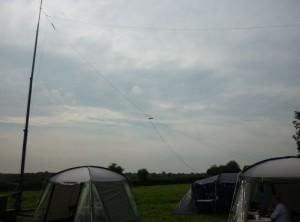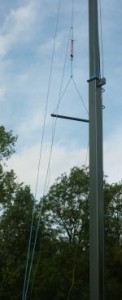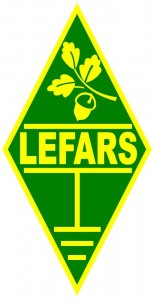The weekend of the 1 / 2 Sept saw the club in the field at Aylmers Farm near Harlow for the Annual Autumn Get-Together. One of the objects of the weekend was to do some antenna testing.
Dave Messenger M3WMV had built a 160/80/40m trapped dipole which was the first aerial to be tested. The traps measured slightly out of band, due in the most part to being unable to get the design height of 85ft at the apex.
The next aerial to be tested was a terminated tilted folded dipole (TTFD). I made the aerial many years ago but never really gave it a test. The aerial proved as good a match as the main aerial, a doublet at some 45ft.
 One end of the TTFD was at 45ft and the other end at 10ft. It was a little noisier than the main but some signals were stronger on the TTFD than on the doublet. This was to be expected as the TTFD is in essence a vertical dipole.
One end of the TTFD was at 45ft and the other end at 10ft. It was a little noisier than the main but some signals were stronger on the TTFD than on the doublet. This was to be expected as the TTFD is in essence a vertical dipole.
The aerial was left in the operating position until Sunday morning so its performance could be judged against the doublet. This aerial may solve the problem of length for those in postage stamp gardens. It does seem to work quite well.
More information on the TTFD here . Note that the non-inductive terminating resistor is a series-parallel arrangement (mine was 450 ohms) and capable of dissipating 33 watts (for 100W output). Also, a 6:1 balun is preferred.
Many years ago now the club was requested to clear Clive G6FWT’s shack who had become SK. We attended the funeral in Sheffield and among his items was a loaded telescopic aerial. I rescued this from the junk pile and cleaned it up. Unfortunately it had been mounted outside for many years and the adjusters on the sliding sections were steel on aluminium and had rusted completely. The repairs completed it was then put in the shed with all the other projects waiting to be tested.
On assembly it was tested on receive and seemed to be reasonably directional, as you would expect from a dipole. However when the analyser was connected it told a different story. The dipole was ‘as is’ from Clive’s and appeared complete. The resonant range of the dipole was fully closed, 17 odd MHz and fully extended 14.800 MHz. This is well outside any amateur band and would have needed an ATU to match, which of course defeats the object of the exercise. The telescopic part of the dipole is too short to be of any use.
John, G8DZH said that Clive had problems getting out with this. Now we know why. In the end Brian 2E0EFX took the aerial to play with. Whether or not it had been modified at some time is anybodies guess.
All in all a good weekend, even the weather was kind, i.e. no rain, a good meal at the R&D and happy campers.
73
John G0VEH (email: g0veh@lefars.org.uk)



